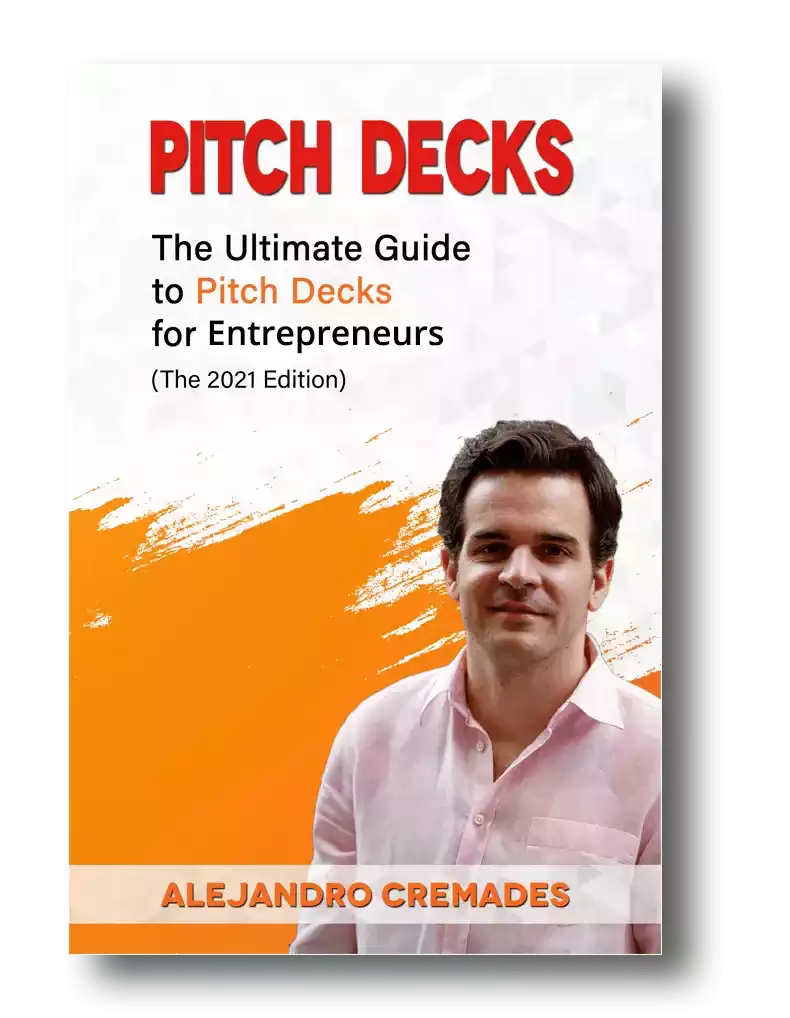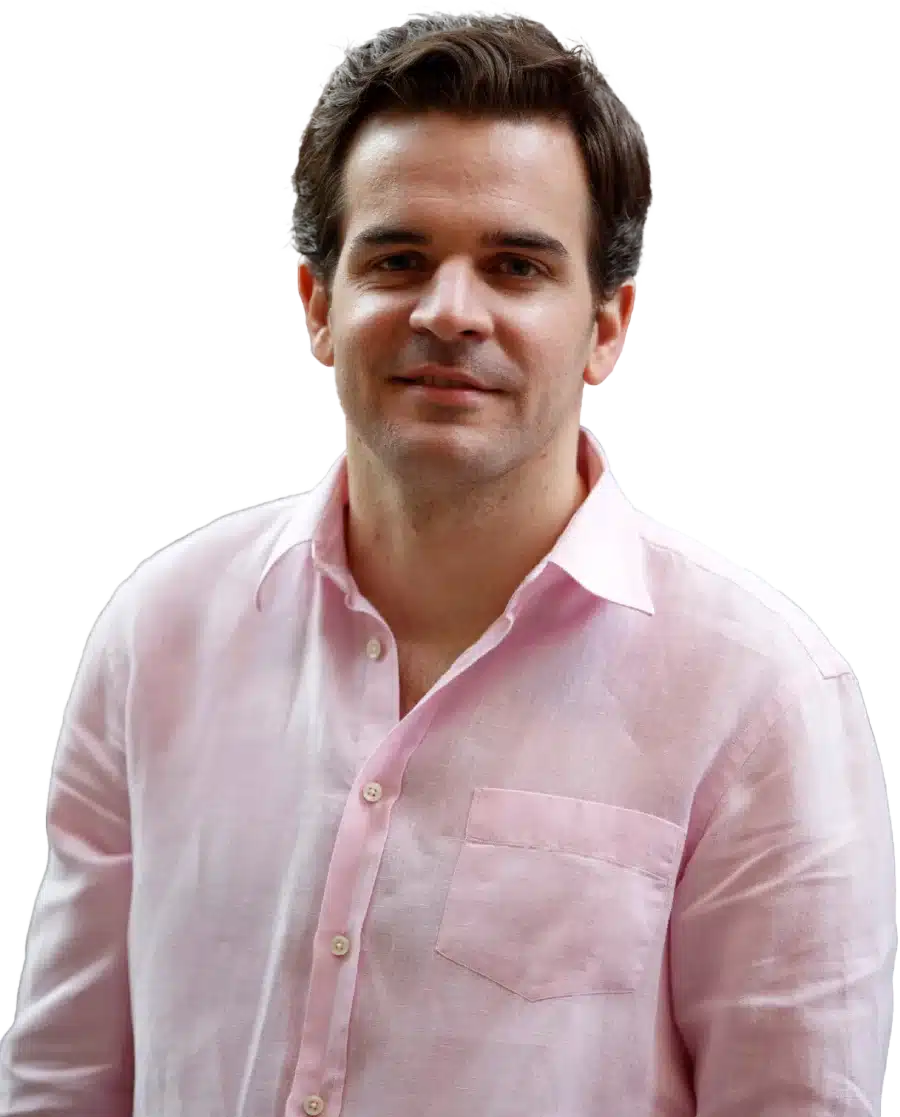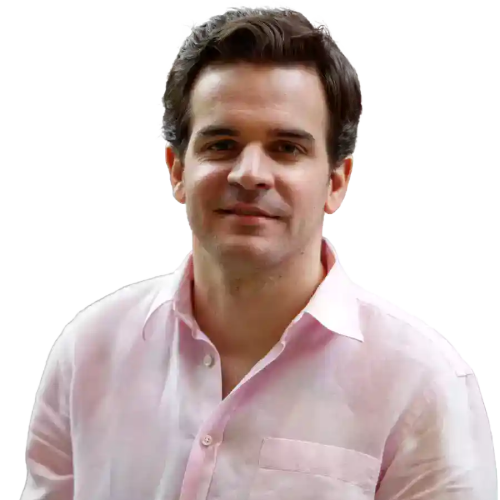Some founders plan every move years in advance. But Sudheesh Nair, the co-founder and CEO of TinyFish, thrives in the chaos of serendipity, making the right choices with the data at hand, learning quickly, and never looking back.
From growing up in a small Indian town to helping build Nutanix into a $20B public company and leading ThoughtSpot into the AI era, Sudheesh’s journey is a masterclass in courage, clarity, and conviction.
In this exciting interview, he talks about the hype surrounding AI and being calibrated by venture capitalists. He also discusses distinguishing between different pieces of advice and picking the ones that worked well for him.
Listen to the full podcast episode and review the transcript here.

*FREE DOWNLOAD*
The Ultimate Guide To Pitch Decks
Growing Up with Simple Joys and Big Lessons
Sudheesh’s story begins in a lower-middle-class family in India in the 1980s and 90s, an era before smartphones, social media, or even cable TV were common. “We didn’t have a lot of money or resources,” he recalls, “But we had family stability, love, great friends, and a good education.”
At that time, they didn’t know anything about the US, except for what they saw on Miami Vice and Baywatch, as he recalls wryly.
Sudheesh credits his upbringing for teaching him a profound truth–happiness often lies in simplicity. “Sometimes we overestimate the power of planning and analysis,” he says. “Then, we miss out on the opportunity that’s right in front of us.” His life has always been about grabbing whatever choices are available.
Sudheesh doesn’t believe in regretting choices even if they go wrong. He’d rather spend time figuring out what went wrong and correcting the error. Those early lessons grounded him, even as serendipity and a well-timed teacher’s recommendation sent his life in an entirely new direction.
The Power of Serendipity and Quick Decisions
While in college, Sudheesh wasn’t even scheduled to attend a certain campus interview. A teacher urged him to go, and he made it just in time. That single decision led him to the US, changing the trajectory of his life.
Sudheesh’s decision-making philosophy would later shape how he built companies, developed and launched products, devised go-to-market strategies, led teams, and even navigated IPOs. All grounded in acting quickly with the info available and conviction rather than waiting for perfect data.
Sudheesh has traveled extensively as part of Nutanix and ThoughtSpot’s worldwide growth. One of the best things that happened to him is the opportunity to travel to almost all the continents and several countries. He firmly believes that every country has something uniquely beautiful about it.
Finding Home in the Bay Area
Today, Sudheesh calls the Bay Area home, not because it’s perfect, but because it celebrates imperfection. “This is one of the few places in the world where failure is not just accepted but valued,” he says. “You can fail and no one holds it against you.”
After traveling to nearly 100 countries, Sudheesh believes human motivations are universal. They are looking for love, safety, and belonging. But what makes Silicon Valley special is its relentless tolerance for reinvention.
Looking back at his life, Sudheesh remarks that he has been in situations that were not the most advantageous for him. But he is grateful for being in a place where failure is just a stepping stone to trying again. “When I land at SFO and drive down Highway 280,” he says, “I feel like I’m driving home.”

Raise Capital Smarter, Not Harder
- AI Investor Matching: Get instantly connected with the right investors
- Pitch & Financial Model Tools: Sharpen your story with battle-tested frameworks
- Proven Results: Founders are closing 3× faster using StartupFundraising.com
Building the Nutanix Story: Competing with Giants
Sudheesh joined Nutanix early, alongside founders Dheeraj Pandey, Mohit Aron, and Ajeet Singh. Together, they built one of the most successful enterprise software companies of the decade, competing head-to-head with giants like VMware.
Sudheesh and the co-founders ultimately took the company public in 2016. It was one of the first tech IPOs of that year. In an uncertain market, deciding whether to take the company public or not was difficult.
But Sudheesh was running go-to-market, and it was clear that customers wanted to see a distinction between private and public companies to invest on a larger scale. Dheeraj and he didn’t stop to analyze things. The decision was right for the employees, investors, and for building lasting value.
For Sudheesh, Nutanix was a story of “fighting out of nothing.” It was a young, fearless team willing to swing at every opportunity. “If you fight like you have a lot to lose, you will lose,” he reflects. “We had nothing to lose, and that made all the difference.”
Two years after the IPO, Nutanix became a $10B business with a $20B+ phenomenal execution story.
Three Core Lessons Learned from Building Nutanix
In retrospect, Sudheesh distills the Nutanix journey into three core lessons:
- Pick the biggest bully in the room. “If you’re not competing with a giant, you’re probably not in a meaningful market.” VMware was their giant.
- Never underestimate customers. They may not understand every technical detail or stay on top of the curve, but they always know what problem they want solved. Listen to them. Sudheesh also underscores a market reach beyond the US, which undoubtedly is the largest market and home to early adopters. While opportunities are not evenly distributed, talent is. Building the infrastructure, support, and references to take on global competition is crucial.
- Filter the noise. “Startups die of indigestion, not starvation. Focus is your sharpest weapon.” At the same time, don’t ignore the signals, but correct course as needed.
Reinventing at ThoughtSpot: From BI to AI
After Nutanix, Sudheesh joined ThoughtSpot. He credits two people with being instrumental in this career trajectory. Ravi Mhatre, the founder of Lightspeed, one of the largest venture capital firms worldwide, is one of them.
The second is Bipul Sinha, who was then also at Lightspeed and is currently the founder and CEO of Rubrik. Ravi was the lead investor of Nutanix and now backed ThoughSpot, a company initially built on the idea of using natural language and AI to deliver Business Intelligence (BI).
One of ThoughtSpot’s co-founders, Amit Prakash, came up with the idea of using natural language to deliver data insights to business users. When the company was founded in 2012, data was on-prem, so the system was built on-prem as well.
But by 2018, the world had shifted to the cloud, and ThoughtSpot needed to evolve. Partnering with founders Amit Prakash and Ajeet Singh, Sudheesh helped reboot the company as a cloud-native platform. Around this time, Snowflake was taking off in a big way.
“We essentially restarted ThoughtSpot,” Sudheesh says. “We went from on-prem to the cloud, from BI to AI.” He intended to leverage his go-to-market expertise from Nutanix, which took it to $1B+. Thus, in 2021, Sudheesh and Ajeet partnered to launch the company on Snowflake.
Next, the company launched integrations with Databricks and Google BigQuery just as AI went mainstream. ThoughtSpot became the AI platform for business intelligence (BI), and Sudheesh’s leadership was central to that transformation.
The Emotional Reality of Leadership
When the company needed to restructure from 300 employees to under 100, Sudheesh faced one of leadership’s most complex tests. “You can’t remove emotion,” he says. “Emotions are the reason you do what you do.”
Sudheesh followed a three-part framework:
- Communicate with extreme clarity. Avoid leaks and uncertainty, and share plans in concentric circles quickly.
- Act decisively with defensible logic. “If you claim you overhired, then you failed as a CEO. Be honest.” The framework has to be defensible.
- Be fair, not just nice. Layoffs should feel just, not performatively empathetic.
Sudheesh adds, “You don’t want to be liked; you want to be trusted. Do the right thing, and that’s enough.” He accepted that some functions would be affected because the company pivoted. But that did not mean that the people they had hired were not the right people.
The functions were just not necessary. The company was transitioning from on-prem to the cloud and didn’t need on-prem resources to maintain and support it. Sudheesh doesn’t believe in wasting time thinking about mistakes; he believes in looking for ways to rectify them.
TinyFish: Reimagining the Web with AI Agents
Today, Sudheesh is building TinyFish, a company born from the intersection of journalism, browser infrastructure, and AI. By automating research and reasoning, TinyFish dramatically reduces the cost and latency of business intelligence.
Sudheesh’s co-founders included Keith Zhai, a Pulitzer-nominated journalist who worked for the Wall Street Journal, Reuters, and Bloomberg, and Shuhao Zhang, a distributed systems expert from Meta and an expert in browser infrastructure, AI, and ML. The trio brought together worlds that rarely meet.
As Sudheesh explains, “We’re building a platform for operating the web. The browser is where the future battles of AI will be fought.”
In his opinion, the internet is where the freshest data has always originated, just as water comes from streams. But the problem is that the water is not drinkable until you filter it. Similarly, filtering data is expensive and requires processing with ETL systems, data warehouses, and BI tools.
The TinyFish Vision
Asked about the TinyFish vision, Sudheesh says–to make the web itself operational through AI agents that act, reason, and extract information like humans. These operational agents can ensure that the data is accurate, cost-effective, and can perform complex tasks.
As Sudheesh points out, 60% of knowledge workers’ time in enterprise companies is spent at a significant scale on various tasks. For instance, competitive analysis, pricing, supply chain research, social sentiment, and website data.
People are researching and compiling that data. Some are scraping data from companies that provide it. However, “imagine a million invisible browsers,” Sudheesh explains. “Each researching, engaging, and extracting fresh data for you, like enterprise-grade digital workers.”
Essentially, digital agents can perform tasks that disrupt human workflows in enterprises, like:
- Mapping competitor pricing strategies
- Assessing credit risk across thousands of candidates
- Gathering real-time supply chain data
- Conducting fraud detection, as in insurance underwriting
- Compiling DNA profiles and other information for clinical research projects
A Business Model Rooted in Enterprise Value
Unlike consumer AI apps chasing virality, TinyFish is laser-focused on enterprise ROI. Companies pay based on usage, the number of agents deployed, and the computational tokens they consume.
“Our model is simple and monetization straightforward,” Sudheesh says. “If we create measurable value, we get a share of it.”
Why AI Isn’t Just a Bubble
Despite the noise around AI hype, Sudheesh believes this moment is as foundational as the Industrial Revolution or the birth of the internet.
As he points out, “The Industrial Revolution unlocked human physical power. The internet unlocked access to knowledge by decoupling it from human domains, and AI unlocks the ability to reason with that knowledge and execute tasks.”
Sudheesh sees the emergence of agentic AI (systems that can think and act autonomously) as the next tectonic shift in human progress. It’s no longer about who has access to knowledge; it’s about who can reason with it and transform it into wisdom.
“Yes, there’s fraud and hype,” Sudheesh admits, “but that doesn’t change the magnitude of what’s happening.” It doesn’t mean that unbelievably value-creating opportunities will not be accessible to companies that are realistic.
Fundraising with Clarity and Discipline
The company has already raised $47M across different tranches, including a Series A round that closed in record time. “We had our first term sheet in less than five days,” Sudheesh recalls. “We knew what kind of investor we wanted and what valuation made sense; we didn’t overthink it.”
Sudheesh emphasized that his team approached fundraising with clarity and discipline. They knew exactly how much they wanted to raise, the investor profile that fit their long-term plan, and the valuation range that made sense without over-rotating on headline price.
For Sudheesh, the quality of an investor outweighs valuation, especially when building a company meant to endure. When ICONIQ’s Amit Agarwal, an operator who spent over a decade at Datadog and served as its president, reached out, the fit was evident.
Sudheesh had long admired ICONIQ’s low-noise, high-value approach. The engagement moved quickly; within hours, they had a rigorous yet fair term sheet. Although multiple firms wanted to lead, the team chose the partner who met their bar without needless back-and-forth.
They closed the round, designed to provide three to four years of runway. Even so, Sudheesh noted the importance of continually building and selectively raising to reset valuation at the right moments. He considers it a fantastic deal for the investors and employees.
Storytelling is everything that Sudheesh Nair was able to master. The key is capturing the essence of what you are doing in 15 to 20 slides. For a winning deck, take a look at the pitch deck template created by Peter Thiel, Silicon Valley legend (see it here), where the most critical slides are highlighted.
Remember to unlock the pitch deck template that founders worldwide are using to raise millions below.
The VC Landscape: Experience vs. Hype
On the broader venture landscape, Sudheesh observed that many founders, especially first-timers, are calibrated poorly by some VCs. Their lack of experience can be confusing, but Gen Z specifically are unbelievably talented when it comes to marketing and creating brands.
Sudheesh draws a distinction between a smaller group of enterprise-savvy institutional investors, who understand the long arc of company-building. These investors are usually in the late-stage growth company sphere but are now entering early-stage sectors.
Sudheesh cited Lightspeed and ICONIQ (now more active at earlier stages), along with firms like Sequoia and a16z, while pointing to standout individuals, such as Vinod Khosla, Ravi Mhatre, and Martin Casado, whose operating judgment he respects.
In Sudheesh’s view, investors who haven’t operated recently or weathered multiple cycles of company building can inadvertently misguide inexperienced founders. This is a newer, louder cohort whose operational depth may be thin.
For those intent on building iconic, long-horizon companies and not just quick wrappers or flips, picking the right person at the early stage matters more than the brand or the platform.
Knowing When to Listen and When Not To
When it comes to advice, Sudheesh uses a simple three-part filter before acting.
- First, he examines the speaker’s motivation for advocating a particular view (for example, a booster for a city in which they may also be invested).
- Second, he checks whether their experience aligns with the subject they’re pontificating about.
- Third, he assumes most advice may not fully apply to his context.
Only after running these checks does Sudheesh parse the content, often finding that a small fraction, such as 7% to 10% or 15% may be valuable, while the majority is not transferable. He appreciates advisors who are explicit about this nuance: what worked for them may or may not work for others.
Sudheesh also reminds founders that they have “backstage access” only to their own company; every other company’s narrative is a stage performance that can look better (or worse) than reality.
Rethinking the Web: From Surface to Depth
Articulating his long-term vision, Sudheesh argued that the web we use today is mainly the surface layer, perhaps 7% to 10% of what exists. For instance, the searches users do on Google and ChatGPT.
The vast 90% majority lives in the deep web, which typical search and LLM interfaces can’t reach. He breaks the inaccessible web into five buckets:
- APIs – such as real-time airline pricing.
- Logins – social platforms and paywalled media. Most of the new data is created behind logins on platforms like the New York Times, Medium, and Substack, among others.
- Workflows – task-specific forms like booking appointments.
- JavaScript-driven personalization – where each user sees something different because retargeting and cookies determine what the website should display.
- The Long Tail of the Internet – valuable results buried far beyond page one.
Sudheesh’s ambition is to make 100% of the web outcome-accessible through agentic AI or systems that can reason, log in, execute workflows, handle personalization, and traverse deep content at scale.
The TinyFish Vision: Outcome-Driven Discovery
Sudheesh’s vision underpins TinyFish. Rather than relying on search (being lost) or browsing (wandering), TinyFish dispatches goal-driven web agents that pursue explicit outcomes.
They can log in, execute a workflow, click at scale, and run JavaScript. These agents can search a website like a human and examine what a machine does.
Sudheesh illustrated the difference with a concrete example: instead of showing a generic first-page list of coffee brands, an agent can dig through dozens of pages to surface a small, ethical Nicaraguan family farm that perfectly matches a buyer’s intent.
Sudheesh pointed to a live case in hospitality: TinyFish has helped surface thousands of small Japanese hotels on Google Hotels—complete with price and inventory—amplifying the “tiny fish” of the internet that otherwise remain invisible.
For Sudheesh, that is the point: shift the web from intermediary-driven discovery to outcome-driven access.
The Final Lesson: Keep Your Head Down and Build
For all his success, Sudheesh remains grounded in humility and execution. “Who you hire, who you raise money from, how you set goals, those fundamentals haven’t changed,” he says. “Ignore the noise. Focus on creating real value. That’s how you build something that lasts.”
Sudheesh closes with a builder’s mindset. The company is just over a year old, and the team is moving fast, grateful to be operating at the crest of a generational wave.
The mandate, as he frames it, is to imagine what seems impossible and to inspire customers with outcomes—rather than simply trying to sell them.
From a small village in India to the epicenter of the AI revolution, Sudheesh Nair’s journey is proof that opportunity doesn’t always arrive planned; it often just shows up, waiting for someone brave enough to say yes.
Listen to the full podcast episode to know more, including:
- Sudheesh Nair’s journey from a small Indian town to leading billion-dollar companies shows the power of clarity, conviction, and adaptability in entrepreneurship.
- His decision-making philosophy—acting quickly with available data rather than waiting for perfect information—became the cornerstone of his leadership style.
- At Nutanix, Sudheesh learned to “pick the biggest bully,” listen deeply to customers, and stay laser-focused amid noise, scaling it to a $20B public company.
- At ThoughtSpot, he led a bold pivot from on-prem BI to cloud-native AI analytics, demonstrating how reinvention fuels longevity in tech.
- With TinyFish, Sudheesh is reimagining the web through enterprise-grade AI agents that operate online like human researchers, automating reasoning and discovery.
- His disciplined fundraising approach—prioritizing investor quality over valuation—reflects a builder’s mindset focused on endurance rather than hype.
- Sudheesh believes AI’s rise rivals the Industrial Revolution, unlocking reasoning power at scale, and reminds founders to ignore the noise and build enduring value.
SUBSCRIBE ON:
Keep in mind that storytelling is everything in fundraising. In this regard, for a winning pitch deck to help you, take a look at the template created by Peter Thiel, the Silicon Valley legend (see it here), which I recently covered. Thiel was the first angel investor in Facebook with a $500K check that turned into more than $1 billion in cash.

*FREE DOWNLOAD*
The Ultimate Guide To Pitch Decks
Remember to unlock for free the pitch deck template that founders worldwide are using to raise millions below.
Podcast: Play in new window | Download
Subscribe: Apple Podcasts | Spotify | TuneIn | RSS | More





Facebook Comments